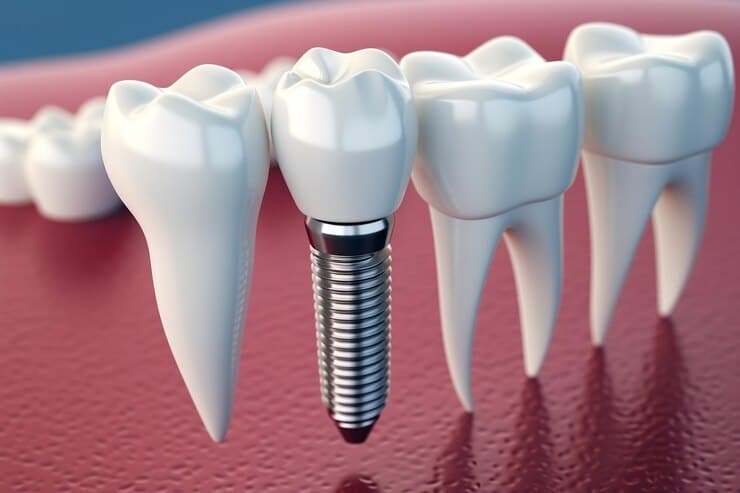
Are you tired of hiding your smile due to missing teeth? Do dentures make you feel like you’re wearing a foreign object in your mouth, causing discomfort and embarrassment? If so, it’s time to consider dental implants! Not only do they offer a natural-looking solution for missing teeth, but they also provide numerous benefits that traditional dentures cannot match. In this blog post, we’ll explore why dental implants are the best choice for anyone seeking a long-lasting solution to their tooth loss woes. So sit back, relax, and get ready to discover how dental implants can transform your smile and boost your confidence!
What are Dental Implants?
If you’re missing one or more teeth, dental implants are the best solution to restore your smile. Dental implants are artificial tooth roots that are placed in your jawbone to hold replacement teeth in place. They look and function just like your natural teeth, and with proper care, they can last a lifetime.
There are many benefits of dental implants over other tooth replacement options, such as bridges and dentures. With dental implants, there is no need to alter healthy adjacent teeth. Dental implants also allow you to eat the foods you love without worry or discomfort. And because they’re designed to fuse with your jawbone, they provide stability and support for your replacement teeth that other options cannot match.
Reasons Why Dental Implants are the Best Solution for Missing Teeth
There are several reasons why dental implants are the best solution for missing teeth. First, when you lose a tooth, the bone that supported that tooth begins to dissolve. This can cause your face to change shape and make it difficult to chew and speak. Dental implants prevent this from happening by providing support for the replacement tooth.
Second, dental implants look and feel like natural teeth. They are custom-made to match the color and shape of your existing teeth so that no one will be able to tell that you have a dental implant.
Third, unlike dentures or bridges, dental implants are permanent. You do not have to worry about them slipping or falling out, and they will not need to be replaced like dentures or bridges every few years.
Fourth, dental implants are good for your overall oral health. They do not require you to alter your healthy adjacent teeth as Bridges does. And because they fuse with your jawbone, they actually help to stimulate bone growth and prevent further bone loss in the jaw.
If you are missing one or more teeth, contact our office today to see if dental implants are right for you!
Benefits of Dental Implants
Dental implants offer a number of benefits over other tooth replacement options. They are strong and durable, they look and feel like natural teeth, and they allow you to eat and speak normally. Additionally, dental implants can last a lifetime with proper care, making them a great investment in your oral health.
Types of Dental Implants
There are three main types of dental implants: endosteal, subperiosteal, and zygomatic. Endosteal implants are the most common type of implant. They are placed in the jawbone and act as a replacement for the root of a tooth. Subperiosteal implants are placed under the gums but on top of the jawbone. They are not as common as endosteal implants because they require a higher level of bone density to be successful. Zygomatic implants are placed in the cheekbone and are used for patients who do not have enough bone density in their jaws to support endosteal or subperiosteal implants.
Endosteal implants are made of titanium and have a screw-like shape. They are inserted into the jawbone during surgery. Once the implant has healed, a small metal post is attached to it. This post protrudes through the gum tissue and acts as a support for a dental prosthetic (false tooth). Endosteal implants can be used to support dentures, bridges, or single crowns.
Subperiosteal implants are also made of titanium but have a frame-like shape. They are placed under the gum tissue but on top of the jawbone during surgery. As with endosteal implants, once the subperiosteal implant has healed, a metal post is attached to it. This post protrudes through the gum tissue and supports a dental prosthetic (
Preparation for a Dental Implant Procedure
The first step in the dental implant process is to meet with your dentist to see if you’re a good candidate for the procedure. During this consultation, your dentist will take X-rays and 3D scans of your mouth to determine the best placement for your implants. If you have enough bone in your jaw, you will be able to move forward with the surgery.
If you don’t have enough bone, you may need a bone graft before getting dental implants. This involves taking bone from another part of your body and placing it in your jaw. Once the graft has healed, you will be able to get dental implants.
Once it’s determined that you’re ready for dental implants, the next step is to schedule surgery. This outpatient procedure is usually done under general anesthesia, so you won’t feel any pain during the surgery.
During surgery, your dentist will make small incisions in your gums and place the titanium implants into your jawbone. Once the implants are in place, your gums will be stitched up and you will be given a temporary denture or bridge to wear while the implants heal.
It takes about three to six months for the implants to fuse with the bone and become strong enough to support a tooth (or teeth). Once this process is complete, you will return to your dentist to have the permanent tooth (or teeth) placed on top of the implant (or implants).

The Dental Implant Procedure
Dental implants are a popular and effective solution for missing teeth. The procedure is simple and straightforward and can be completed in one or two visits to the dentist. Here’s a look at the dental implant procedure:
First, the dentist will examine your mouth and take X-rays to determine if you are a good candidate for dental implants. If you are, the next step is to prepare your mouth for surgery. This involves cleaning the area around the tooth and making sure there is enough bone to support the implant.
Next, the dentist will place the implant into your jawbone. Once in place, the implant will need to heal for several months before the artificial tooth can be attached. During this time, you may have a temporary tooth placed over the implant site.
Once the implant has healed, you will return to the dentist to have your artificial tooth (or teeth) attached. The tooth will be made to match your natural teeth in color and shape. With proper care, dental implants can last a lifetime!
Aftercare Tips for a Successful Recovery
If you’re considering dental implants, you’re probably wondering what the recovery process will be like. Here are some aftercare tips to help ensure a successful recovery:
1. Follow all of your oral surgeon’s instructions. This is important for preventing infection and ensuring proper healing.
2. Keep your mouth clean. Brush your teeth gently with a soft-bristled toothbrush and avoid smoking.
3. Eat soft foods. Avoid crunchy or hard foods that could damage your implants. Stick to soft foods like soup, mashed potatoes, and yogurt for the first few weeks after surgery.
4. Take it easy. Avoid strenuous activity for the first few days after surgery to allow your body to heal properly.
5. Don’t forget to floss! It’s important to keep your implants clean by flossing daily, just as you would with natural teeth
Alternatives to Dental Implants
When it comes to replacing missing teeth, dental implants are often considered the best solution. However, there are other options available that may be a better fit for some patients. Below is a list of alternative solutions for missing teeth:
Dentures: Dentures are false teeth that are fitted to the gums and held in place with adhesive. They can be removed and put back in at any time and don’t require surgery to place. However, dentures can be uncomfortable and unstable, making it difficult to eat and speak. They also need to be replaced every 5-7 years as they wear down.
Bridge: A dental bridge is an artificial tooth that is placed in between two healthy teeth. The healthy teeth act as anchors to hold the bridge in place. Bridges are semi-permanent and usually last around 10 years before needing to be replaced. Like dentures, bridges can make eating and speaking difficult and may require special care to keep clean.
Partial Denture: A partial denture is similar to a full denture, but only replaces some of the teeth instead of all of them. Partial dentures are usually more comfortable than full dentures and don’t require as much care. However, they still need to be replaced every 5-7 years.
All in all, dental implants are the best tooth replacement solution for those who have lost a tooth or several teeth due to injury, disease, or age. Not only do they look and feel natural, but they also offer more stability than other types of replacements such as dentures. Furthermore, their longevity makes them cost-effective over time and allows you to maintain your oral health with ease. If you’re considering replacing missing teeth with an implant-supported restoration, be sure to consult your dentist about your options so that you can get the best results possible.
Dental implants are an artificial replacement for a natural tooth. They are usually made of titanium, which is a biocompatible material that integrates with the jawbone.
Dental implants are considered the best solution for missing teeth because they are strong and durable. They also look and feel like natural teeth, so you can eat and speak normally. Additionally, since dental implants fuse with the bone, they help to preserve the bone structure in your jaw.



